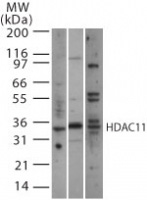HDAC11 antibody (pAb)
Host / Isotype
Rabbit / IgG
Reactivity
Human, Mouse, Rat
Applications
WB
Cat No : 39208 39208
Synonyms
Validation Data Gallery
Product Information
| Tested Applications |
WB
Applications Validated by Active Motif: WB: 1 - 3 ug/ml dilution For optimal results, primary antibody incubations should be performed at room temperature. The addition of 0.1% Tween 20 to all blocking solutions may also reduce background. Individual optimization may be required. |
| Tested Reactivity | Human, Mouse, Rat |
| Host / Isotype | Rabbit / IgG |
| Class | Polyclonal |
| Type | Antibody |
| Immunogen | This HDAC11 antibody was raised against a peptide corresponding to amino acid residues 238-251 of human HDAC11. |
| Full Name | HDAC11 antibody (pAb) |
| Synonyms | HDAC, HDAC11, HDAC-11, HDAC 11, pAb, polyclonal, Histone deacetylase 11, antibody, antibodies |
| Molecular weight | 36 kDa |
| GenBank accession number | NP_001129513 |
| RRID | AB_2614938 |
| Purification Method | Affinity Purified |
| Buffer | PBS containing 0.2% gelatin and 0.05% sodium azide. Sodium azide is highly toxic. |
| Storage | Some products may be shipped at room temperature. This will not affect their stability or performance. Avoid repeated freeze/thaw cycles by aliquoting items into single-use fractions for storage at -20°C for up to 2 years. Keep all reagents on ice when not in storage. |
Background Information
HDAC11 (Histone Deacetylase 11) is a member of the class IV mammalian histone deacetylases (HDACs) involved in regulating chromatin structure during transcription. These enzymes catalyze the removal of acetyl groups from lysine residues of histones and other cellular proteins. Lysine N-e-acetylation is a dynamic, reversible and tightly regulated protein and histone modification that plays a major role in regulation of gene expression in various cellular functions. It consists of the transfer of an acetyl moiety from an acetyl coenzyme A to the e-amino group of a lysine residue. In vivo, acetylation is controlled by the antagonistic activities of histone acetyltransferases (HATs) and histone deacetylases (HDACs). The HDACs are grouped into four classes, on the basis of similarity to yeast counterparts: HDAC class I (HDAC1, HDAC2, HDAC3 and HDAC8), class II (HDAC4, HDAC5, HDAC6, HDAC7, 9 and 10), class III (SIRT1-7) and class IV (HDAC11). In humans, expression of HDAC11 is limited to only a few organs, including brain, heart, muscle and kidney, suggesting an important role of HDAC11 in those tissues.

